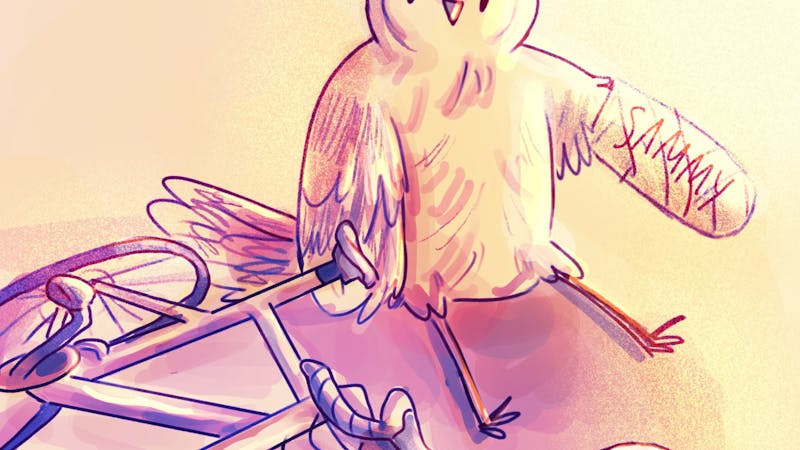HART’s Roman holiday

Ten undergraduate Owls have flown back from a summer in Italy, unveiling their study abroad experience in the HART in the World: Rome exhibition. Located on the first floor of Herring Hall, the student-organized exhibition features a line-up of photographs, sketches and research projects on display until the fall of 2025.
Led by a professor and a doctoral student, the HART in the World program sends students abroad every other year. This year, Sophie Crawford-Brown, an assistant professor of art history and the director of ancient Mediterranean civilizations program, took students to Rome.
“It is a particularly interesting program because it changes city and faculty leader every time it’s offered,” Crawford-Brown said. “It is designed so that students can be exposed to a long history of art and culture from a major cultural capital in the world, led by a faculty member who does research in that place. I work on Roman archaeology, so I offered to take the students to Rome.”
Student participants intended for the HART in the World exhibition to appear as an old, reworked document according to business and art history double major Will Marsden, who went on the trip and helped create the exhibition.
“We just really wanted to focus on Rome being sort of a palimpsest, something that is added to and kind of erased, but you can still see remnants of what might be left behind,” Marsden, a McMurtry College sophomore, said. “That’s pretty much how Rome is like through art and architecture.”
The exhibition reflects discussions about Rome in the HART in the World class, Crawford-Brown said.
“[The palimpsest is] sort of the metaphor we use for talking about Rome, because it’s been built on all these layers, one on top of another, but you can still see all of these layers of history,” Crawford-Brown said. “That’s sort of the overarching principle they had for the exhibit, with them going in rough chronological order through time as well. But in the exhibit, too, you can see how things are going back and forth.”
Students take a seminar in the spring to gain historical background before spending three weeks abroad in the summer. The following fall, they design and organize the exhibit.
According to Eilis Livia Coughlin, the teaching assistant of the program, students also exhibited individual research projects that they worked on over the course of the class. Students started the project in the spring class, then gathered research materials on the ground in Rome, she said.
For their research projects, students explored various topics from art to public spaces according to Ella Langridge, an art history and medieval and early modern studies double major who went on the trip.
“I think some of the stuff that I enjoyed most … was working on my independent research during weekends,” Langridge, a Lovett College junior, said. “I was doing the project where I found this old poem that gives you a pilgrimage route to follow through Rome [that] I tried to follow as closely as I could … It was great, because what I was studying was sort of the affective and emotional experience of being a pilgrim, and you were really able to tap into those sorts of beautiful, universal human experiences in those places.”
Elizabeth Fessler, an art history and history double major, said that going on the trip with a professor and teaching assistant was invaluable.
“Because we were there with our professor and our TA who know so much and have such deep knowledge, they were able to share more in depth things about everywhere we went,” Fessler, a Jones College senior, said. “At the Colosseum, there's always discussion of if they used to flood it and host battleship games in there. Because our professor studies Roman history and Roman art history, she was able to tell us where the state of research was on that and how likely … that theory was, whereas I think a regular tour guide probably would have told you that as if it was fact.”
Coughlin said she was happy to go as the teaching assistant on the trip.
“I was born in Rome and I lived there for a lot of my life … so it’s a place I know really well and that I love a lot,” Coughlin, a doctoral student in art history, said. “The fact that I could bring together my love for Rome with my love for teaching … sounded great to me.”
Students also gained access to a recently discovered archaeological site in San Casciano dei Bagni, where they got to see the excavation process.
“I remember hearing about [the San Casciano site], and I thought, wow, that's so interesting,” Marsden said. “We all got to go to that site where they discovered these new bronze Roman sculptures, and that's an experience I never thought I would have had, and I never thought I would have been interested in.”
More from The Rice Thresher

New student center to ‘complete’ central quad
Breezeways, arches and outdoor seating will abound at the Moody Center Complex for Student Life set to break ground May 8. The 75,000-square-foot complex was designed by architecture firm Olson Kundig and has an expected completion date of fall 2027.

Best study snacks to fuel your finals
Finals are creeping up on us, and that means hunting season for the best study snacks on and off campus. Below are some that are sure to see you through the most enigmatic paper prompts and puzzling practice questions.

Head over handlebars: a brief history of Beer Bike accidents
In the first heat of the women’s race in this year’s Beer Bike, Melissa Geng said she was biking faster than she ever had, adrenaline pumping through her veins. All was going well, until she crashed into the fence of the alumni viewing area at the turn of her second lap.

Please note All comments are eligible for publication by The Rice Thresher.